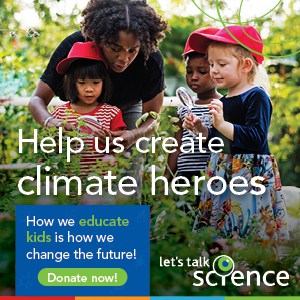It’s one thing to say there’s nothing more important than giving kids the tools for the world of tomorrow. It’s quite another to speak through action. That’s where STEM (science, technology, engineering and math) education comes in, especially according to teachers on the front lines.
Issues like public health, climate change, sustainable development are front and centre, but those challenges won’t be met with social media chatter and sensationalist headlines. Those challenges are going to need to be met on the front lines of the education system, with scientific and technological expertise.
Let’s Talk Science is a national charitable organization committed to preparing youth in Canada for future careers and citizenship roles in a rapidly changing world, with events and symposiums, projects, competition series, resources and support for educators to help them improve youth engagement in STEM. They offer up a robust suite of programming for kids aged 3-17, available in English and French.
Philanthropy is so essential here – enabling those educators who run the program to offer it free to schools, early year centres, community organizations and parents, according to Suiyang Yin, an educator from Toronto utilizing Let’s Talk Science resources. She is the impact on kids on a daily basis in her classroom (Valley Middle School in North York, Ont.).
What’s your history with Let’s Talk Science resources in your classroom?
I found Let’s Talk Science through their STEM club, I think 2020 or 2021. You just sign up for STEM club, which is free, then you have Let’s Talk Science staff to conduct a science experiment, virtually, via Google Meet or Zoom, then they deliver it to whomever signs up for that. And that’s a weekly program – 30 minutes to one hour. The whole class joins. After that I signed up for the Teacher Leader program. And the next year I became a Teacher Leader with them.
They have all these beautiful activities, all free, high-quality activities that students really enjoy.

It sounds like it’s a program that from a teaching perspective, in terms of tools for you, there’s a lot of flexibility built in, so you can custom build it for each of the students?
Yes. It’s a break sometimes, just to switch and engage in science for that half an hour or hour.

What are the Let’s Talk Science resources that you are tapping into right now?
My best is definitely the the stem cohort, which I’ve been doing for two years. But in the past two years, I’ve been … a teacher leader with Let’s Talk Science. I just come back to my community, to my school, and I just invite a few educators who are interested to join the stem cohort. So a bunch of teachers who are passionate about STEM education, we come together, we do lunch and learns. And we talk about how to teach STEM in a more effective way.
And one of the greatest things that this brings to us is that we can actually get the robots. They have a list of gadgets that are available. So every year I bring in from Let’s Talk Science, a computational classroom kit, with robots and coding resources. And then the teachers, we come together, we play around with it, come up with some lesson planning. And then we take turns. The first year I brought this in, so many teachers were so interested. I think all the junior grades participated – there were over 10 classes that participated. We made a schedule – each class got to use it for two weeks, and then just incorporated it with social studies and science units. Yeah, so it was a huge success.
So lots of kids actually had the experience to just use the gadgets, with coding. It’s not like our school didn’t have coding resources. We did have microbits, but we’ve found, especially with younger kids, they don’t engage that much with microbits. So we brought in something … color coding, block coding. It’s just great to see all those students, especially girls, thrive with this coding.

According to the news, many schools are failing when it comes to things like math proficiency. How important is STEM, especially to kids in junior level grades, and are you sensing a real thirst among kids that age to learn STEM?
I’m really grateful to be able to connect with Let’s Talk Science, because they have the vision to prepare our youth for the future.
When I was growing up, we didn’t have smartphones. But kids now have all this access to digital gadgets and they are learning, but they need to spend their time really use technology well, instead of just browsing social media. They need to work towards another direction, to learn how to really use technology.
It’s a different world right now. So I really feel this vision, to prepare them – especially getting girls to code – this is a big thing for me. Get them to know what’s going on, like, what this coding is about, and how do you get started. I feel like having the gadgets for them to play around with, to start from maybe just color coding, then to coding. You’re telling them that this is not that challenging. It’s not just for boys, you can do it. Just get them started. It’s so important, but many schools just don’t have the resources. And teachers didn’t learn about this in teachers college. So to bring those resources in for teachers to even to play around with, get familiar with it, the kids have a good feeling about it and we are more passionate about teaching it. that’s how I see it.
Let’s Talk Science really lets the students see how STEM impacts their life, understanding broader implications of their learning, and really fosters a sense of responsibility toward the world. With using the gadgets, there so many topics that we can just dig deeper. Because it’s not just the gadgets. Let’s Talk Science has learning pathways and lots of professional learning and lots of great topics for students. They have Sustainable Development Goals involved in real life concepts. So, to have those meaningful conversations, together with the computational, really helps the kids to not just, you know, learn things from books. They can code, they can use the gadget to make an impact, and make a difference.
How important is it that these resources are offered for free?
It’s very important. Those gadgets are so expensive. Kids are engaged and also, they feel this is something that they can do, and that builds confidence. So I think it means so much to make it free. It’s equitable access to learning opportunities. With Let’s Talk Science, everything is there, a whole variety of resources, free.
I am a teacher leader with Let’s Talk Science. We have great science teachers here, and this is something else I can offer. It’s a great opportunity for science teachers to sit down together and get to know each other and brainstorm about STEM education ideas. Let’s Talk Science has a learning pathway where there’s great lesson plans in it. It’s all culturally relevant, and touches on real world concept related to STEM education.
Top image by Chris Liverani on Unsplash

Mark Keast has been a journalist for three decades, starting out as a sports writer and editor for one of Toronto’s largest daily newspapers. Recently he has moved into writing on luxury cars, travel, and Toronto luxury real estate. He owns real estate in downtown Toronto as well, so there’s a vested interest there. Mark spends a lot of his work time connecting with realtors and developers across Canada, staying on top of industry developments.
Check out his stories, and email him direct at mkeast@regardingluxury.com








